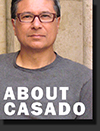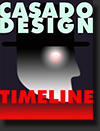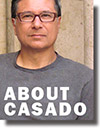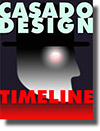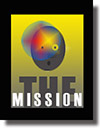Creative Methodology
Now that we have covered the basics, The Brain Trilogy, we can begin to have some fun and start getting down to the root of what we are all after – how to be more creative.
Albert Einstein said, “Problems can not be solved by the same level of thinking that created them.” This is especially true for all of us who come from different disciplines –each takes different levels of creativity. An advertising art director or writer, industrial designer, interactive designer, graphic designer, painter, financial advisor, dancer, and the list could go on, all want something different from creativity. Therefore, the way each of them go about problem solving will be different.
Being human is having empathy.
The one thing everyone has in common when it comes to a methodology is having empathy. Simply put, empathy is the art of understanding and feeling for another person. I don’t think we are born with it, but it can be developed easily. One of the fastest ways to gain empathy is to change places with someone and see how it feels to be in their shoes. You have to be able to let go of your biases and prejudices. One can really get deep into this subject of empathy, but for our purposes of developing our creativity we need to have a curious and empathetic mind to really be successful.
Basic approaches to solving problems and sparking your imagination.
There are many approaches to creative problem solving. For example, David M. Kelley, the founder of the design firm IDEO and a professor at Stanford University has a distinctive methodology about how to build your creative confidence. He gave a TED.com speech on the subject and has written numerous books. He suggests that everyone has creative potential. It’s like a muscle and needs to be strengthened and nurtured through effort and experience. When presented with a design problem he presents four steps for seeking feasibility, desirability and viability, which converge to create innovation. The steps are:
Inspiration
Synthesis
Ideation
Experimentation
Mr. Kelley believes that these four steps form a system of overlapping spaces rather than steps. Inspiration is basically the problem that motivates you to find a solution. Synthesis brings all your creative thoughts together to draw a conclusion. Ideation is generating and testing ideas. Experimentation is finding out whether your ideas work. Even great creative minds fail, but they do more experimenting than anyone else. Mistakes can be a great source of new ideas. David Kelley also believes that another source of ideas is to engage in the world around you. Keep track of the things that bug you as well. From this- good ideas will emerge.
One conclusion.
In as much as I understand what David Kelley is saying, his method assumes you are in touch with your creativity. His method may work for some and not others. All methods are a form of deductive reasoning to reach a conclusion, and it stands to reason that not any one single method is going to work for everyone. However if you know various methods, you will begin to adapt and build an approach that best works for you to spark creative ideas. Another reason for developing your own unique method is to get you to start thinking faster and closer to that “what if ” question. Remember when you ask that question you get a lot stuff that’s unusable but the real answer is very close by and may be just under your nose. Look at the unusable stuff as false starts or the mistakes that will lead you closer to your goal.
The method I created for myself.
Growing up in the 50’s I wanted to be an artist, but my parents really pushed me to stick to science and math through school. They were concerned that I would starve as an artist and so they hoped I would end up a doctor or dentist or form financial groups who bought real estate. I reached my second year in college when I threw my hands up in the air and said I can’t do this- I have to be a creative person. I ended up at the Art Center College of Design where I graduated as an advertising art director and eventually moved on to becoming a graphic designer with a reputation for being on the leading edge. Every assignment started with a deadline. I had to move fast and it had to be smart. My method was built from parts. Since I had spent so much time in science and math, the scientific method was drilled into my head. Later, this was a very good first step-by-step approach to discovering the answers I needed for creative solutions. I used it in the beginning and then morphed it to make it work for me. Both the Scientific and Engineering methods are too restrictive for my way working today, but they have some good steps.
The Scientific Method
- Ask a question
- Background research
- Pose a hypothesis
- Test the hypothesis
- Analyze the data and come to a conclusion
- Communicate the results
There is also an Engineering Method:
- Define the problem
- Background research
- State the requirements
- Brainstorm, evaluate, and choose solutions
- Develop prototypes
- Test the solution
- Match solution against the requirements
- Communicate the results
The parts that I use from both of these methods are also useful when I have to present creative solutions to a client. I like to define the assignment back to the client and make sure everyone agrees with it. Next I make everyone agree to the requirements the solution must meet. When I “communicate the results”(present the work), I do it with as much enthusiasm as possible. I once again restate the problem and the requirements we all agreed to. This makes your clients part of the solution and more likely to agree with you choice.
Back in the studio, part of my method is to state the obvious once I identify the problem. This is where I use empathy a lot. I try and bring in those answers that will be shocking to people because I know that people enjoy being shocked. Another part is the cliché, which is very valuable to me. I love it when someone, who is evaluating my idea, says, “ Everyone knows that!” If everyone knows that, then it’s works!! The trick here is the cliché has to have a new twist. Disguise it. I try and isolate myself when I work so I don’t have to worry about my fears. The fears of being judged before the problem is resolved. The fear of people seeing the idea too soon and it not meeting all their requirements. I try and work very fast to avoid my brain from being too rational in the beginning. It’s another way to get the bad ideas out of your head.
Here is where I agree with David Kelley. All of my “steps” are not done in an orderly manner. They all overlap and rearrange themselves as I work. The one step that is hard to understand is allowing my emotions to come out as I work. I am my own cheering section. I always ask myself, “How can this be “shocking and new.” And lastly, I continue to reduce the whole solution to the simplest form or answer, so it’s like a bulls-eye.
These days, I don’t ask other people’s opinion about my ideas, except my wife’s, because my method is so personal. I have been doing this for so long, that I can’t imagine any other answer than the one I have created that day. This is justified because my clients expect me to be confident. I can’t afford to be wrong. This is where the salesmanship comes in. Once again, you need to present to your ideas with so much enthusiasm that you get a standing ovation.
A true story.
Years ago, I was asked to re-design the branding for Esprit, a youthful clothing company in San Francisco, and was given the deadline of two-months by the president. I worked for the allotted time and made my presentation. I presented him with the one choice, among many, that I thought was the best solution for their branding problem. The president was speechless and asked if that was all that I had to show him. He went on to say that it looked too simple and wasn’t sure it was the answer. He asked me go back to my studio and come back with a new presentation.
I went back to my design office and put my presentation in a corner, out of sight. A few weeks later I made another appointment with the president and went back with the exact same presentation. He was horrified that I didn’t make any effort to change the presented trademark. I simply said that this was the answer. He looked at me and said with a serious tone in his voice “ I hope you are right”. That was 1979 and today Esprit is a billion dollar company headquartered in Germany still using that same trademark. That story is a real testament to creative confidence and enthusiasm.
A methodology is a good thing. As you develop one- it will become second nature. People have often said to me that they could tell if a solution came from me. In the beginning, after hearing that comment, I would become annoyed with myself for not being able to do something so unique that my audience would not be able to tell if it came from me. Today, I smile and simply say thank you. The solutions are who I am.
